It never ceases to amaze us all the animals that there are in the world. Our oceans and waters make up 71% of the Earth’s surface. And when thinking about those numbers, it is no wonder there are some 3.5 trillion fish.
Out of these vast numbers, we are alphabetizing each of the fish by their common names. And we have now reached the letter “O.” Let’s dive right in by looking at the ocean perch fish.
Ocean Perch (Sebastes alutus) Facts
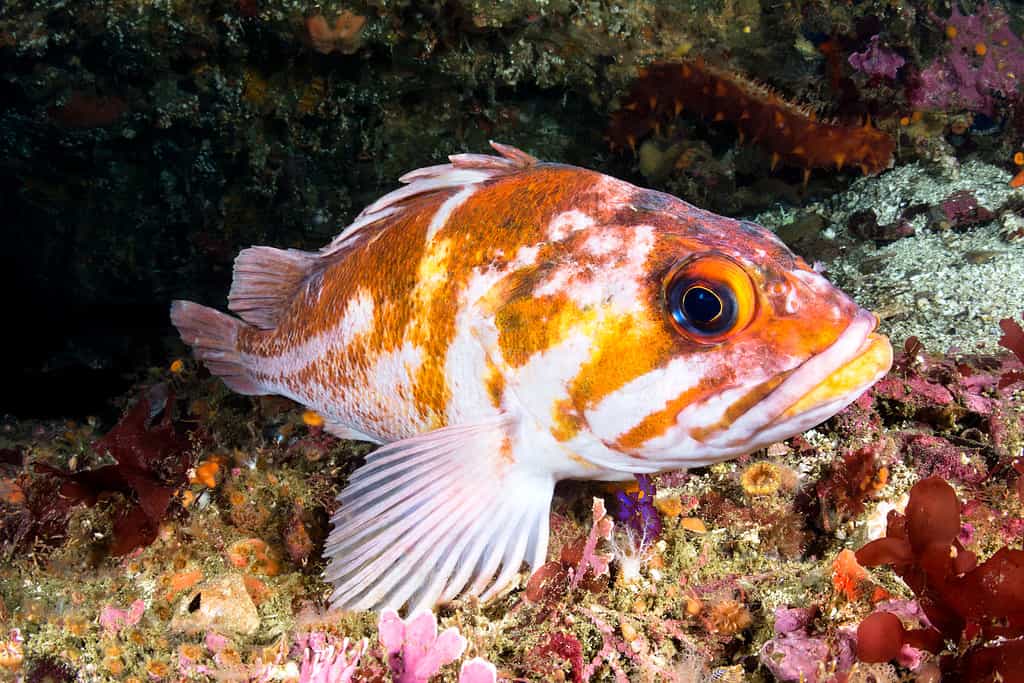
The Pacific Ocean perch is also called
rockfish
.
©Joe Belanger/Shutterstock.com
The ocean perch (Sebastes alutus) is a colorful-looking fish that is red or pink in appearance. They have scales along their body and spines along its back. These fish can be found in locations such as Asia, Eurasia, North America, and various oceans worldwide.
Ocean perch fish live in a school-type environment. And because of this, they are no strangers to predators in the ocean. Sea creatures such as sablefish, halibut, sperm, whales, salmon, lingcod, seabirds, and rockfish will hunt these schools of fish and eat what they can.
They will eat plankton to keep up with their small appearance. They weigh approximately four pounds and reach 20 inches long.
Ocean Pout (Zoarces americanus) Facts

The ocean pout possesses unique proteins in its blood that allow it to survive extremely cold temperatures.
©https://www.flickr.com/photos/dkeats/5532424100/ – License
Not to be confused with the ocean perch, the ocean pout (Zoarces americanus) is a completely different fish. And as we could imagine, this fish has a “pout” like look on its face, just as its name suggests.
The ocean pout of the family Zoarcidae can be found in various oceans worldwide. They can grow to be 46 inches long and weigh up to 14 pounds. As you may have thought, yes, this fish is a family member of the eelpout family, hence the family name Zoaricdae. Its lengthy appearance gives that one away.
Ocean pout’s eat a variety of invertebrates, crustaceans, and mollusks. They are hunted by larger prey such as seals, sculpins, and skates.
Oilfish (Ruvettus pretiosus) Facts

Oilfish contain high levels of wax esters, which are indigestible to humans.
©Porco_Rosso/Shutterstock.com
The oilfish (Ruvettus pretiosus) is a spiny-looking fellow that can be found in the deep sea about 2,600 feet below surface level. They can survive in both temperate and tropical waters.
As carnivores, the oilfish will feast on squid, small fish, and crustaceans. Their growing appetite helps them to weigh as much as 140 pounds and reach 5-10 long. Due to this size, the oilfish’s predators are tunas and marlins.
Opah (Lampris guttatus) Facts
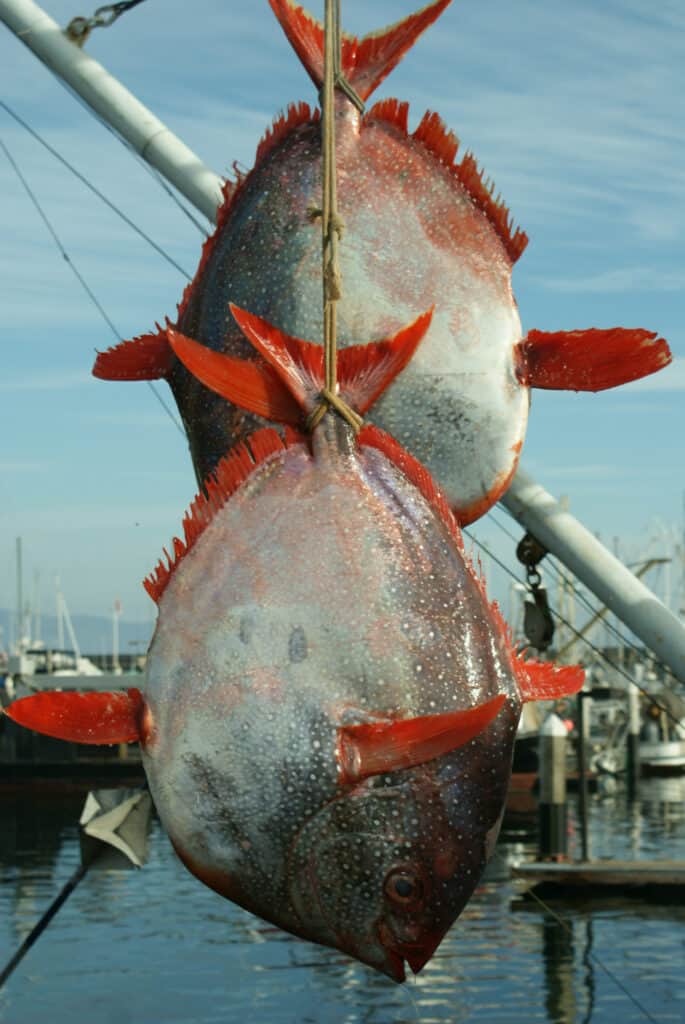
Opah fish are nearly circular, with their bodies being nearly as wide as they are long.
©Vanishingfin/Shutterstock.com
Opahs (Lampris guttatus) are vibrant-colored fish that are red, orange, and silver in appearance. Reaching 3-6 feet long, these lengthy sea creatures can also reach between 100-600 pounds.
The opah can be found to reside in the Pacific Ocean, Indian Ocean, North Atlantic, and Mediterranean Sea. Their exact habitat location is largely dependent on the species of opahs. There are currently six species of opah.
These carnivores are solitary hunters that will feast on squid, krill, and other small fish. Not too many fish in the ocean can compete with a 600-pound predator, so the only other known animal to hunt and eat opahs is the great white shark and the mako shark.
Opaleye, Rudderfish (Girella nigricans)

Opaleye rudderfish are omnivores.
©Podolnaya Elena/Shutterstock.com
The opaleye (Girella nigricans) of the family Kyphosidae are found in North America. While this fish might look rather bland in its picture, it can be yellow, blue, black, and green in appearance. These lengthy sea creatures can grow to 66 centimeters (26 inches) in length.
They prey on sea animals such as crustaceans, worms, mollusks, and marine algae as well. They live in a group-like behavior known as a “school of fish.”
A school of fish is defined by Science Focus as “A school is a group of the same fish species swimming together in synchrony; turning, twisting and forming sweeping, glinting shapes in the water.”
Orange Roughy (Hoplostethus atlanticus)

In the 1970s, fisheries stopped referring to orange roughy as slimeheads to make them more marketable as commercial fish.
©Brendan Lin/Shutterstock.com
Orange roughy (Hoplostethus atlanticus) fish have partially received this common name due to their orange-like appearance that they have. Although this is the main color we will see, the orange roughy scales can also look yellow, red, blue, black, and white as well.
The orange roughy can weigh up to 15 pounds and grow to 30 inches long. Their behavior in the ocean is a group behavior in a school environment as well. They feast on zooplankton, crustaceans, shrimp, fish, and squid.
There has been a very low decline in their population status, and because of this, the orange roughy is considered to be an endangered species. The biggest threat to their survival is overfishing.
Orchid Dottyback (Pseudochromis fridmani) Facts
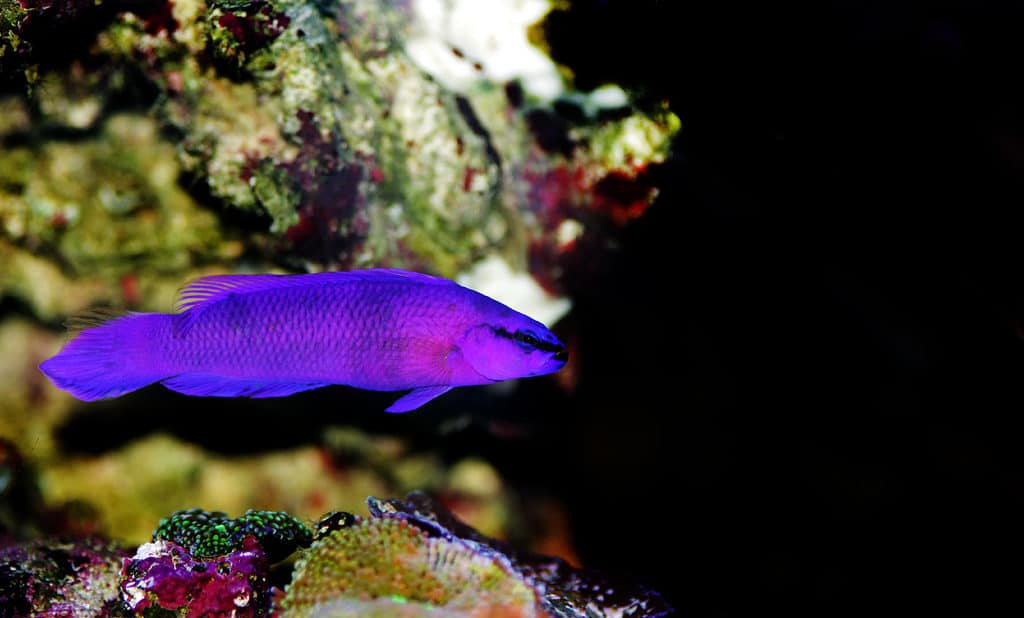
Unlike some other aquatic creatures who can change their colors on a whim, orchid dottybacks cannot. Their transformations can take several days to complete.
©Vojce/Shutterstock.com
The orchid dottyback (Pseudochromis fridmani) is a brightly colored fish that is purple in appearance. While purple, this fish has the amazing ability to trick its prey and predators by camouflaging itself to its surroundings.
They can be found in Australia, Asia, and in the Red Sea, to name a few locations. As carnivores, the orchid dottyback will feast on plankton, damselfish, and smaller docile fish.
Oscar Fish (Astronotus ocellatus) Facts

Despite being a bit moody, Oscar fish are affectionate, often referred to as “river dogs.”
©weter 777/Shutterstock.com
Oscar fish (Astronotus ocellatus) of the family Cichlidae, interestingly enough, has teeth in its throat. If that didn’t creep you out enough, make sure to keep on reading about this fish.
The oscar fish are found in habitats in Europe, North America, and South America. As such, they feast on freshwater clams, snails, shrimp, insect larvae, catfish, and insects.
These incredibly fast fish can reach up to amazing speeds of 60 miles per hour, making them difficult prey to catch. However, it’s not impossible to catch them. Piranhas, waterbirds, reptiles, and humans are known to hunt and catch the oscar fish.
Oyster Toadfish (Opsanus tau) Facts
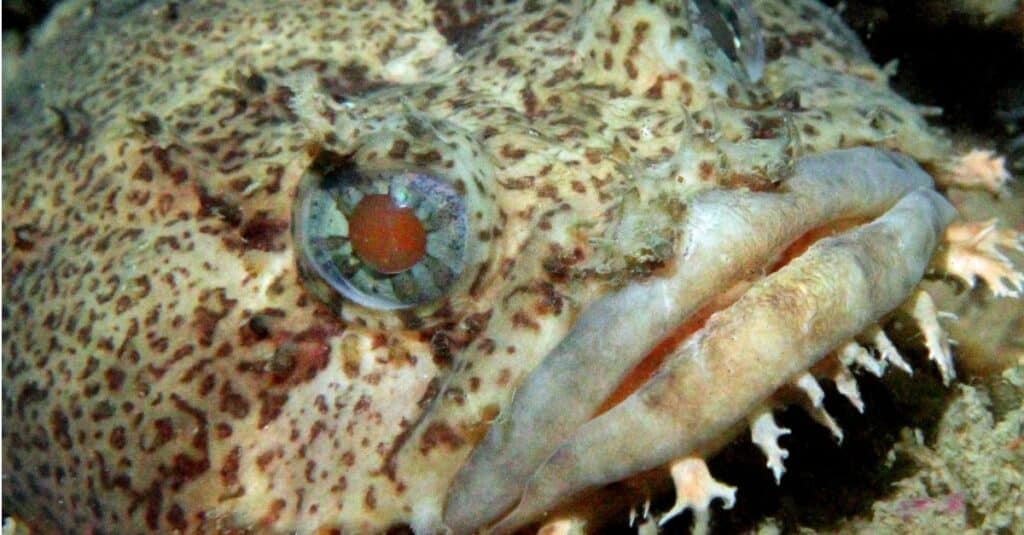
Oyster
toadfish
can live up to 24 years in the wild.
©iStock.com/Swimwitdafishes
The oyster toadfish (Opsanus tau) known for its toad-like appearance, is brown, black, and yellow in appearance. Only weighing between 3-5 pounds and reaching 8-17 inches, this rather small fish likes to stick to himself.
The distinguishing factor about this fish is his big eyes that we see in the picture here!
Oyster toadfish prey on mollusks, crustaceans, squids, worms, and other fish. They are prey to sharks and other larger fish.
Ozark Bass (Ambloplites constellatus) Facts
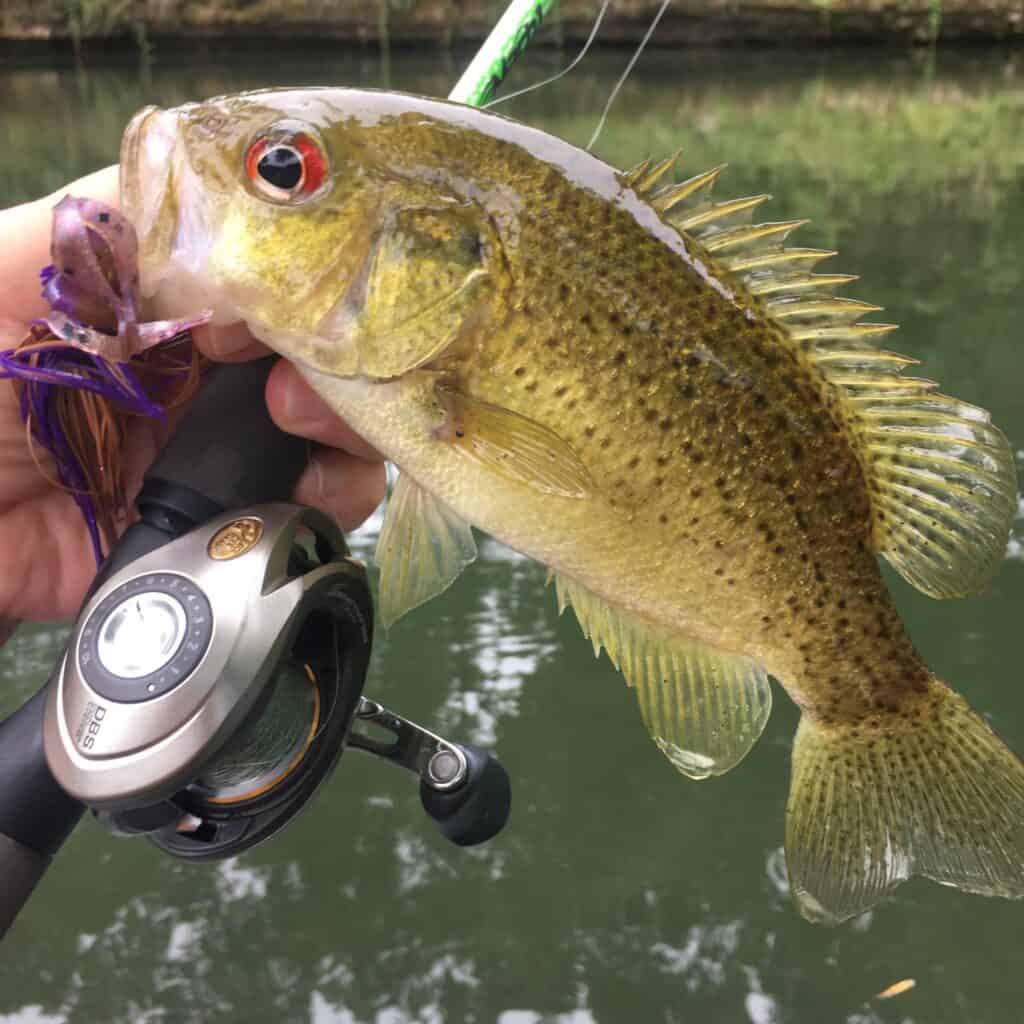
The Ozark bass are mysterious fish and not much is known about them.
©cornysweaterman/CCBYSA4.0 – License
Ozark bass (Ambloplites constellatus) live in very specific locations. They can only be found in North America in Arkansas and Missouri. Oddly enough, for only being found in specific locations, few things are known about their population status and natural predators.
These funny-looking fish also go by the name “Google-eye” due to their large red eyes. The Ozark bass is a small little guy that weighs between 3.69 ounces and one pound. They will prey on minnows, crayfish, and insects.
Largest Fish That Starts with the Letter “O”
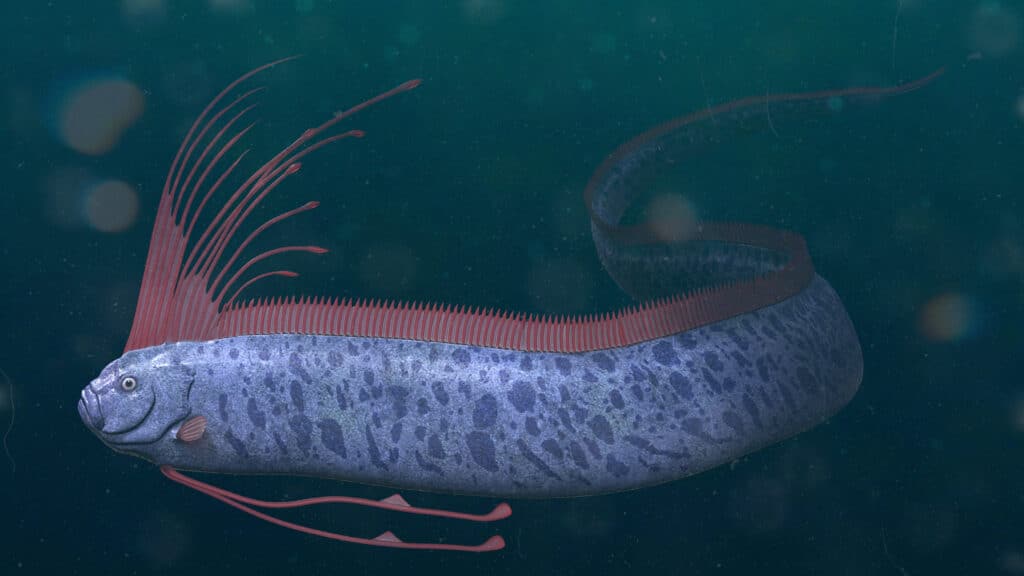
The Giant oarfish (Regalecus glesne) holds the Guinness Book of World Records for the longest bony fish in the world.
©Dotted Yeti/Shutterstock.com
While we have seen the below list of over 95+ fish, the oarfish (Regalecus glesne) holds the title for one of the largest fish that starts with the letter “O.” Not only is it one of the absolute largest fish, the giant oarfish is actually in the Guinness Book of World Records for the longest bony fish in the world.
If you hop on over to the Guinness Book of World Records, you will see just how incredibly long and huge this fish is! They can grow to be 56 feet long and weigh up to 600 pounds. To give you an idea of how long that is, think of a semi-truck trailer. Those are typically 53 feet long. So, just imagine swimming in the ocean, and a semi-truck trailer comes right at you!
To keep up with their size, these carnivorous fish hunt and eat krill, shrimp, plankton, squid, and other small fish. Because of the little research available on these fish, it is difficult to understand all of their hunting patterns. What we do know is the oarfish are solitary hunters.
It is assumed that these giant fish are hunted by large sea creatures such as the great white shark and orcas. Given how big oarfish are, it would make sense that their only predators are those who can compete with them in size.
Now that we’ve shared the largest fish we could find with the letter “O,” we can now shift our focus to see the complete list of fish whose common names start with the letter “O” and their scientific names.
Complete List of 95+ Fish That Starts with the Letter “O”
| Common Name (Fish that start with “O”) | Scientific Name (Fish that start with “O”) |
|---|---|
| Oscar | Astronotus ocellatus |
| Old Wife | Enoplosus armatus |
| Oarfish | Regalecidae |
| Ocean Sunfish | Mola mola |
| Oceanic Whitetip Shark | Carcharhinus longimanus |
| Olive Flounder | Paralichthys olivaceus |
| Obese Synodontis | Synodontis obesus |
| One lined pencilfish | Nannostomus unifasciatus |
| Olga cory | Corydoras simulatus |
| Oneline tetra | Nannaethiops unitaeniatus |
| Orange chromide | Etroplus maculatus |
| Okefenokee pygmy sunfish | Elassoma okefenokee |
| Ornate rainbowfish | Rhadinocentrus ornatus |
| Ocellated puffer fish | Leiodon cutcutia |
| One-gilled swamp eel | Ophisternon bengalense |
| Orangespotted sunfish | Lepomis humilis |
| Octozona barb | Eirmotus octozona |
| Ornate pimelodus | Pimelodus ornatus |
| Ocellated freshwater stingray | Potamotrygon motoro |
| Otorongo ray | Potamotrygon castexi |
| Orinoco peacock bass | Cichla orinocensis |
| Onespot barb | Puntius terio |
| Ornate tetra | Hyphessobrycon bentosi |
| Oil catfish | Centromochlus perugiae |
| Odynea pimelodid catfish | Pimelodella odynea |
| Orinoco angelfish | Pterophyllum altum |
| Okavango tilapia | Tilapia ruweti |
| Oaxaca cichlid | Vieja zonata |
| Odo cichlid | Nandopsis haitiensis |
| Orangethroat darter | Etheostoma spectabile |
| Ocellated snakehead | Channa pleurophthalma |
| Ornate bichir | Polypterus ornatipinnis |
| Ocellated bushfish | Ctenopoma muriei |
| Oxyrhynchus tube-snouted ghost knifefish | Sternarchorhynchus oxyrhynchus |
| Orange-finned danio | Danio kyathit |
| Odessa barb | Puntius padamya |
| Orange fin merry widow | Phallichthys amates |
| One-lined African characin | Nannaethiops unitaeniatus |
| Opaline gourami | Trichogaster trichopterus |
| One spot betta | Betta unimaculata |
| Obscure snakehead | Parachanna obscura |
| Ocellate river stingray | Potamotrygon motoro |
| Orange-lined reef basslet | Akysis vespa |
| One-spot butterflyfish | Chaetodon unimaculatus |
| Okinawa goby | Gobiodon okinawae |
| Ornate surgeonfish | Acanthurus dussumieri |
| One-stripe anthias | Pseudanthias fasciatus |
| Orange lined reef basslet | Liopropoma swalesi |
| Orange diamond goby | Valenciennea puellaris |
| Oxeye herring | Megalops cyprinoides |
| Orange shoulder tang | Acanthurus olivaceus |
| Orange blotch surgeonfish | Acanthurus olivaceus |
| Orange skunk clownfish | Amphiprion akallopisos |
| Orbicular batfish | Platax orbicularis |
| One spot foxface | Siganus unimaculatus |
| Orchid dottyback | Pseudochromis fridmani |
| Oriole angel | Centropyge bicolor |
| Ocellated lionfish | Dendrochirus biocellatus |
| Ornate wrasse | Thalassoma pavo |
| Orange-lined triggerfish | Balistapus undulatus |
| Oblong blowfish | Takifugu oblongus |
| Orange spotted sleeper goby | Valenciennea puellaris |
| Orange lined cardinalfish | Apogon cyanosoma |
| Orange anemonefish | Amphiprion sandaracinos |
| Oualan forktail blenny | Meiacanthus oualanensis |
| Ocellated dragonet | Synchiropus ocellatus |
| Ocellaris clownfish | Amphiprion ocellaris |
| Old glory | Amblygobius rainfordi |
| Orange firefish | Nemateleotris magnifica |
| Orange spotted shrimp goby | Amblygobius guttata |
| Orange sea perch | Pseudanthias squamipinnis |
| Orbiculate cardinalfish | Sphaermia orbicularis |
| Orangebanded stingfish | Choridactylus multibarbus |
| Oblique-lined dottyback | Cypho purpurascens |
| Orange spotted goby | Amblyeleotris guttata |
| Orangetip bristletooth | Ctenochaetus tominiensis |
| Oranda | Carassius auratus auratus |
| Otocinclus cat | Otocinclus vestitus |
| Ornate wrasse | Thalassoma pavo |
| Orangespine unicornfish | Naso lituratus |
| Orange fin barb | Barbus eutaenia |
| Onespot squeaker | Synodontis notata |
| Orange clownfish | Amphiprion percula |
| Orange spotted spinefoot | Siganus guttatus |
| Ornate butterflyfish | Chaetodon ornatissimus |
| Ocean Perch | Sebastes alutus |
| Ocean Pout | Zoarces americanus |
| Ocean Whitefish | Caulolatilus princeps |
| Oilfish | Oilfish |
| Opah | Lampris guttatus |
| Opaleye (Rudderfish) | Girella nigricans |
| Orange Roughy | Hoplostethus atlanticus |
| Oscar Fish | Astronotus ocellatus |
| Oyster Toadfish | Opsanus tau |
| Ozark Bass | Ambloplites constellatus |
The photo featured at the top of this post is © Minakryn Ruslan/Shutterstock.com
Thank you for reading! Have some feedback for us? Contact the AZ Animals editorial team.






